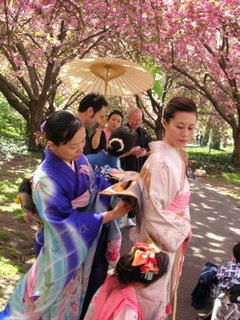
This photo was actually taken at an ethnic festival in Brooklyn NY, by Wendy Zarganis, who has a column about local events on About.com. (I tried to put in a link but didn't succeed, sorry) but it beautifully illustrates this book that I found in a hospital waiting room and slyly slid into my bag to take home with me. It does bother my conscience a tiny bit, thinking about the next person who comes along and has to be content with tattered Harlequin Romances, but there wasn't time to read the whole thing there and, well, I just had to know if Yukiko ever finds a husband! Besides, it's quite an old paperback, printed in 1966, and it was falling apart in my hands as I read, so it's unlikely that anyone could have read it after me.
Maybe I'm just the last one in the world to know, but I've never heard of this book or this author, Junichiro Tanizaki ("author of THE KEY and SOME PREFER NETTLES") before. According to the blurb on the book, he was already very famous in Japan when this book was first published in 1957. It was written in Japanese and translated into English by Edward G. Seidensticker. It's the story of four sisters from a merchant class family in the years leading up to and including World War II (but it doesn't go as far as Pearl Harbour).
While quite distinct in style and content, it strongly resembles a Jane Austen novel, with perhaps a dash of Georgette Heyer. Although there are some delightfully humorous scenes, the author can't match Jane Austen's subtle wit, but makes up for it with intriguing, complex characters and fascinating scenes of daily life, combined with a story line that manages to keep you (me) turning the pages. My Harlequin-programmed mind naturally focussed on the two unmarried sisters as the heroines. A husband must be found for Yukiko, the third sister, before Taeko, the youngest, can be married to the man she already loves. This is why it's important for Yukiko to find someone soon, but she's not one to settle for just anybody. In the end, I find to my surprise that it's Sachiko, the second sister, and her wonderful husband Teinosuke who are the true heroine and hero. What a darling couple!
I'm totally charmed by the seasonal celebrations that mark the passing years. Each spring the sisters go together to view the cherry blossoms, wearing their beautiful silk kimonos, and have their photograph taken together on a bridge. Didn't I tell you the picture above is perfect? I don't know when I've wished harder that a book was illustrated. There's a festival just for admiring the harvest moon. Imagine that. The whole family spends an entire evening admiring the moon, writing poems to it, painting pictures of it, and remembering family members who are not there to share it with them.
At the same time, I have been very surprised by the degree to which this family's life is "westernized". They drink coffee for breakfast, have "western" rooms as well as "Japanese" rooms in their houses, wear foreign clothes, go to movies, listen to foreign music as well as traditional, speak foreign languages, and occasionally go out for barbecued chicken. In spite of this, the Makioka sisters - except, perhaps, for the youngest, Taeko - live quite comfortably with their deeply traditional heritage, perhaps because it's been one of wealth and privilege.
These people, even the youngest and flightiest of them, think long and hard before they speak. They ponder. They discuss. They debate. They consider all the points of view, and all the possible outcomes, and do their very best to make prudent choices. There's plenty of pressure to conform, but individuals are left to make their own decisions to a remarkable degree.
I would love to see this story made into a miniseries. A good one, a BBC type, with close attention to background and mood, and less to sex and sensationalism. What are the chances, I wonder?
No comments:
Post a Comment